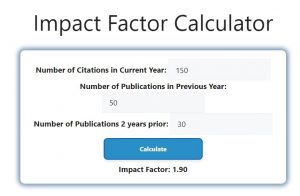About Impact Factor Calculator (Formula)
The Impact Factor (IF) is a critical metric in the academic world, used to assess the significance and influence of scholarly journals. It provides a quantifiable measure of the average number of citations received by articles published in a journal over a specific period. The Impact Factor Calculator is a vital tool for researchers, editors, and institutions aiming to gauge the importance of academic publications in their respective fields. This article will explain the formula for calculating the Impact Factor, how to use the calculator, provide an example, and answer frequently asked questions regarding this essential tool.
Formula
The formula for calculating the Impact Factor is as follows:
IF = Cy / (Py−1 + Py−2)
Where:
- IF is the Impact Factor
- Cy is the total citations in the current year to articles published in the previous two years
- Py−1 is the number of articles published in the previous year
- Py−2 is the number of articles published two years prior
How to Use
Using the Impact Factor Calculator involves a few simple steps:
- Gather Required Data: Collect the following information:
- Total citations in the current year (Cy)
- Number of articles published in the previous year (Py−1)
- Number of articles published two years prior (Py−2)
- Input Values: Enter the collected data into the calculator’s designated fields.
- Calculate the Impact Factor: Click on the calculate button to obtain the Impact Factor using the provided formula.
- Interpret the Results: Analyze the Impact Factor value to understand the journal’s influence. A higher Impact Factor indicates a more significant influence within the academic community.
Example
Let’s consider an example to illustrate the use of the Impact Factor Calculator:
- Total citations in the current year (Cy): 150
- Number of articles published last year (Py−1): 50
- Number of articles published two years ago (Py−2): 30
Using the formula:
IF = 150 / (50 + 30)
IF = 150 / 80
IF = 1.875
In this case, the Impact Factor is 1.875, suggesting that articles in this journal have received, on average, nearly two citations each in the current year.

FAQs about the Impact Factor Calculator
- What is the Impact Factor?
The Impact Factor is a measure of the average number of citations to articles published in a specific journal. - Why is the Impact Factor important?
It helps assess the journal’s influence and reputation within the academic community, guiding researchers in their publication choices. - How often is the Impact Factor calculated?
It is typically calculated annually. - What does a high Impact Factor indicate?
A high Impact Factor indicates that articles in the journal are frequently cited, suggesting a strong influence in the field. - Can the Impact Factor be used to compare journals?
Yes, it can be used to compare the relative influence of different journals within the same discipline. - What are the limitations of the Impact Factor?
It does not account for the quality of individual articles or the context of citations and may favor certain fields over others. - How can I find the Impact Factor of a specific journal?
You can usually find it on the journal’s website or in databases that track journal metrics. - Does the Impact Factor consider self-citations?
Generally, reputable sources aim to exclude self-citations to provide a more accurate measure. - What is the difference between the 1-year and 2-year Impact Factor?
The 1-year Impact Factor only considers citations from the previous year, while the 2-year Impact Factor includes citations from the last two years. - How does the Impact Factor influence publishing decisions?
Researchers often choose journals with higher Impact Factors to increase the visibility and credibility of their work. - Can I use the Impact Factor for any type of publication?
No, it is primarily used for academic journals, not for books or other types of publications. - Is the Impact Factor the only metric to consider?
No, other metrics like h-index, CiteScore, and SCImago Journal Rank should also be considered for a comprehensive evaluation. - How does the number of articles published affect the Impact Factor?
A larger number of published articles can dilute the Impact Factor if citations do not increase proportionally. - What are some common misconceptions about the Impact Factor?
Many believe it solely reflects the quality of research, but it primarily measures citation frequency, which can vary by field. - Can an Impact Factor change significantly from year to year?
Yes, changes in citation patterns or the number of articles published can lead to fluctuations in the Impact Factor.
Conclusion
The Impact Factor Calculator is an invaluable tool for assessing the influence and relevance of academic journals. By understanding the formula and how to use the calculator, researchers can make informed decisions about where to publish their work. Despite its limitations, the Impact Factor remains a widely recognized metric in the academic community, helping to evaluate the significance of research contributions. As the landscape of scholarly publishing evolves, being aware of various metrics and their implications will empower researchers to navigate their publishing journeys effectively.